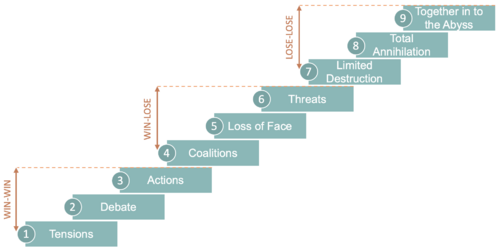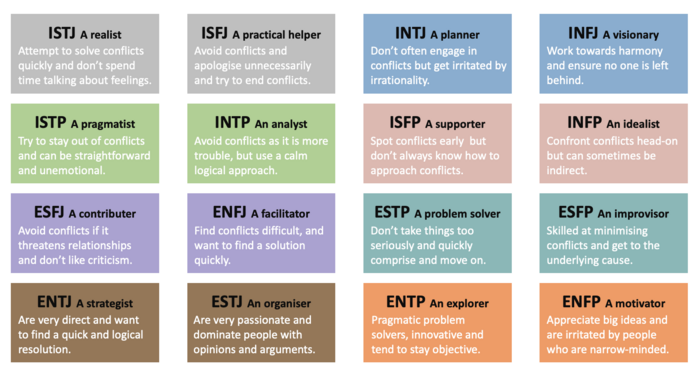MBTI in Conflict Management
(→Manage arising conflicts to be constructive) |
(→Identification of conflict pairs) |
||
| Line 50: | Line 50: | ||
=== Identification of conflict pairs === | === Identification of conflict pairs === | ||
[[File:Screenshot 2023-05-02 at 14.20.42.png |thumb|500px|right| Figure 4: The four conflict pairs. Conflicts often happen when MBTI types differ in preferences however they particular tend to happen between two MBTI types hold opposite preferences in terms of the last two letters. | [[File:Screenshot 2023-05-02 at 14.20.42.png |thumb|500px|right| Figure 4: The four conflict pairs. Conflicts often happen when MBTI types differ in preferences however they particular tend to happen between two MBTI types hold opposite preferences in terms of the last two letters. | ||
| − | <ref name="Book"/>. | + | <ref name="Book"/><ref name="MBTI">. |
]] | ]] | ||
Revision as of 09:55, 8 May 2023
Written by Anna Hessellund Diedrichsen
Contents |
Abstract
The article provides an examination of the application and advantages of Myers–Briggs Type Indicator(MBTI) in conflict management relevant to project management. Conflicts happen in all projects and by mastering the skills of conflict management, conflicts in team will lead to better outcomes and improve productivity. Conflict management relates to prevent conflicts from happening and resolve conflicts before escalation. Based on that the project manager(PM) must tailor behaviour, communication style and conflict management. MBTI is a tool that can be used to provide insights about a person's preferences concerning differences in how the person perceives information and makes decisions[1].
The fundamentals of MBTI is explained emphasising the four preferences, Extraversion vs. Introversion, Sensing vs. Intuition, Thinking vs Feeling and Judging vs. Perceiving, which combined assesses the way an person prefers to perceive information and make decisions. A person is assigned to one of 16 personality types. Further, the article argues for the application of MBTI in conflict management by emphasising the different MBTI types preferences linkage to the core activities in managing conflicts addressing how potential conflicts are identified, causes of conflicts and how to solve conflicts. Lastly, a critical reflection discusses limitations of MBTI.
Conflict Management
Conflict management relates to managing the team with the purpose of motivating the team and fostering a positive work environment according to DS/ISO 21502 [2]. The purpose of conflict management is to foster positive conflicts in a team. It is an essential soft skill to engage stakeholders and navigate in difficult situations to maximise performance and productivity [3][4]. From a pluralist viewpoint organisations consist of stakeholders having different values and goals where conflicts can be constructive[3]. Conflict management is the process of preventing conflicts, addressing them, and resolving conflicts before they escalate. It is the art of managing arising conflicts and finding a mutually acceptable solution that satisfies both parties by identifying differences in values, preferences, and approaches present in a team [5]. Empathising different conflict management styles is of essence to manage conflicts constructively.

Conflict escalation model
The model of conflict escalation developed by Friedrich Glasl describes nine stages and three levels of conflict escalation. It is of interest to identify and solve a conflict in the earlier stages to ensure win-win result between parties, illustrated on figure 2[6]. Thereby, conflicts can be positive and lead to better outcomes hence it is relevant to understand individual preferences, needs and interactions across team members [3].
Causes of conflicts
Conflicts inevitable arise due to 10 causes in the process of developing team effectiveness, and are products of numerous variables leading to arguments between people competing personal interests. The most significant conflict causes are identified by prof. Y. AS from University of Johannesburg [7].
- Disagreements escalating
- Poor organisational structure
- Personality clashes / differences in values & goals
- Poor communication
In order to improve conflict management which involves preventing conflicts from happening and managing arising conflicts, MBTI is a useful tool to gain understanding of individuals' behaviour in a team and in a conflict.
Myers–Briggs Type Indicator (MBTI)
The purpose of Myers-Briggs Type Indicator tool is to support project management to understand individuals in a team in order to manage them appropriately.
The Concept
The invention of Myers–Briggs Type Indicator assessment by Katharine Cook Briggs and Isabel Briggs Myers originates from the theory described by C. G. Jung about analytical psychology[8] . MBTI provides an examination of the individual’s conscious feelings and thoughts with the purpose of emphasizing differentiation in the way people perceive information and make decisions. Hence, MBTI discusses the individual’s preferences and not capabilities. It is the world’s most universally and widely used assessment tool to understand the individual's preferences and determine type. To clarify it is not a personality test but a test assessing a person's type [9].
The purpose of MBTI is to assess individual preferences which connect to preferred behaviour in teamwork, interactions and thereby understand how team dynamics arise and are likely to communicate and interact. The underlying assumption is that people have specific preferences which impact its behaviour pattern. MBTI empathises eight preferences which are paired into opposite preferences of two. An individual tends to favour one of two opposing preferences and will feel energetic, natural and competent when using a preferred preference however, by practice people can master the proficient of using the opposite preference. Awareness about MBTI enable teams to leverage different personalities and strengths to increase effectiveness.
The 16 MBTI Types
Overall, MBTI eight preferences can be combined and expresses a total of 16 different personality types, illustrated on figure 3. An individual's psychological type is represented by four preferences and reflects its behaviour and thinking in group work and conflicts.

MBTI considers 4 preferences, collectively comprising the foundation of the individual’s personality type.
- Orientation: The category assesses where a person focuses its attention distinguishing between Introversion(I) and Extroversion(E). A tendency to prefer Extroversion focusses on the outer world emphasizing the power of engagement with people and activities. People who prefer Introversion focusses on the inner world of impressions and ideas.
- Perception: The category assesses the way a person perceives and interprets information considering Sensing(S) and Intuition(N). A person who prefers Sensing tends to focus on “here and now”, gathering information through senses. A person who prefers Intuition tends to gather information based on previous patterns and seeks the wider context and future possibilities.
- Judgement: The category assesses how a person makes rational decisions based on perceived information by distinguishing between Thinking(T) and Feeling(F). A person who prefers Thinking makes decisions based on logical arguments, defined rules and objective analysis. A tendency to prefer Feeling means a person makes decisions based on values and subjective consideration associating with the situation.
- Orientation: The category assesses the way a person deals with the outer world distinguishing between Judging(J) and Perceiving(P). A person who prefers Judging enjoy planning and an organised approach in contrast to a person who prefers Perceiving enjoy flexibility, keeps options open and like being spontaneous.
Identification of conflict pairs
[[File:Screenshot 2023-05-02 at 14.20.42.png |thumb|500px|right| Figure 4: The four conflict pairs. Conflicts often happen when MBTI types differ in preferences however they particular tend to happen between two MBTI types hold opposite preferences in terms of the last two letters. [9]Cite error: Closing </ref> missing for <ref> tag
[3]
Cite error:
<ref> tags exist, but no <references/> tag was found